Table Of Contents

Lalit Janardhan Katare

Koyel Ghosh
Aerospace and Defense Domain: Allied Market Research’s Top 5 Emerging Markets in Q2’24

The aerospace and defense domain has witnessed a massive upsurge in recent times due to some obvious reasons. Almost all major regions across the globe are witnessing geopolitical tensions and wars which have a direct impact on the sector. The Israel-Palestine conflict, Russia-Ukraine war, clashes between Armenia-Azerbaijan over the Nagorno-Karabakh region, China-Taiwan dispute, etc., have brought the aerospace and defense domain into focus. The rising menace of terrorism around the world has led to many countries ramping up their defense technologies to counter the threats posed by non-state actors. This has also played a major role in the rise of the sector in the second quarter of 2024.
To offer businesses comprehensive insights into the factors influencing its growth, Allied Market Research recently published a study analyzing the top 5 emerging markets in the sector. With the help of its in-house ‘Title Matrix Tool’, AMR has selected five industries, based on parameters such as CAGR values and revenue numbers, which have transformed the domain massively in Q2 2024. Furthermore, extensive reports on each of these markets have also been published which cover the growth drivers, opportunities, upcoming trends, and latest developments in the landscape.
Military Antenna Market
Military antennas perform the all-important task of transmitting and receiving signals by converting radio frequency into electrical pulses. These antennas are widely used in armored vehicles, warships, military aircraft, radars, etc., for surveillance, reconnaissance, communication, and surveillance. The AMR report on the military antenna market that the growing applicability of these advanced devices in various military vehicles and systems is expected to help the landscape flourish in the coming period. The report highlights that the industry, which accounted for $3.7 billion in 2021, is set to gather a revenue of $6.7 billion by 2031, thereby rising at a CAGR of 6.1% from 2022 to 2031.
The AMR report classifies the realm of military antenna on the lines of platform, application, frequency, and end-use. Based on application, the SATCOM segment is estimated to be the most profitable in the forecast period owing to several reasons. In the past few years, satellite communication (SATCOM) technologies have been increasingly integrated with military antenna systems for beyond-line-of-sight communications. Furthermore, with the advent of Internet protocol (IP)-based applications, the demand for satellite communications has increased which is predicted to open new avenues of growth in the forecast period.
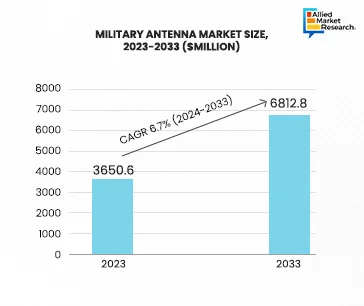
Military Cybersecurity Market
Allied Market Research recently published a report on the military cybersecurity market which states that the industry is set to gather a revenue of around $68.5 billion by 2033 and surge ahead at a CAGR of 15.4% from 2024 to 2033. As per the AMR study, several governments across the globe have significantly increased their defense budgets and military spending which has enhanced the growth rate of the landscape. Furthermore, the use of emerging technologies such as AI, 5G, and cloud computing is anticipated to help the industry expand in the next few years.
The AMR report also focuses on the performance of the industry in major regions across the globe including North America, LAMEA, Europe, and Asia-Pacific. As far as the military cybersecurity landscape is concerned, the North America region is estimated to have the fastest growth rate in the forecast period. The United States of America has the highest military spending in the world and the US government has consistently invested in advanced technologies to modernize their defense capabilities, as a result of which the industry has flourished primarily in the province.
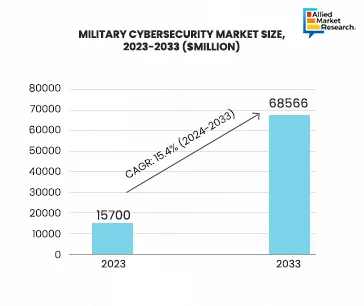
Defense Cybersecurity Market
In the past few decades, the incidences related to cybercrime, cyber terrorism, and cyber theft have increased exponentially. The defense and military installations are particularly at risk and enemy forces try to disrupt the networks that connect these installations. Hence, defense cybersecurity technologies are in high demand as they detect, report, and tackle cyber threats and protect important military infrastructure from incidences like data breaches or cyber theft. As a result of the growing popularity of these state-of-the-art technologies, the defense cybersecurity market is anticipated to gather a revenue of $43.4 billion by 2031 and surge ahead at a CAGR of 7.7% from 2022 to 2031 period.
Apart from focusing on the growth drivers and opportunities, the report also studies the various segments of the market on the lines of type, deployment, solution, and application. Based on application, the communication networks segment is predicted to be the most profitable in the years to come. In the past few years, the demand for defense cybersecurity solutions for protecting critical communication networks has increased massively. The advancements in technologies related to command, control, communications, computers, combat systems, and intelligence, surveillance, & reconnaissance (C5ISR) have contributed to the growth of the industry in Q2 2024.
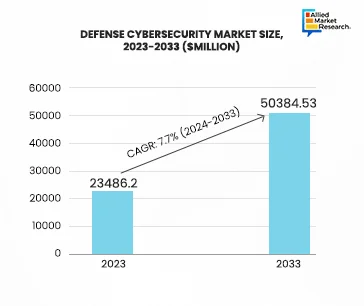
Anti-Drone Market
The anti-drone market, which was valued at $1.3 billion in 2021, is predicted to gather a revenue of $14.6 billion by 2031, thereby growing at a CAGR of 27.9% from 2022 to 2031 period. Anti-drone, as the name suggests, is a set of technologies used to detect and destroy the capabilities of unmanned aerial vehicles. The increasing use of unmanned aerial vehicles for different activities has led to challenges concerning privacy, security, and surveillance. As a result, the demand for anti-drone technologies has increased to deal with these challenges and protect important infrastructure facilities like airports, nuclear power plants, government buildings, etc.
The regional analysis of the anti-drone landscape covers the performance of the market in various provinces like North America, Asia-Pacific, Europe, and LAMEA. As part of the study, major countries in these regions such as the US, Canada, the UK, Germany, France, India, Japan, China, etc., are analyzed comprehensively. In the case of the anti-drone industry, Asia-Pacific is expected to have the fastest growth rate of 30.6% in the forecast period. The increasing investments in anti-drone technologies by several governments in this province have played an important role in the rise of the market in the second quarter of 2024.
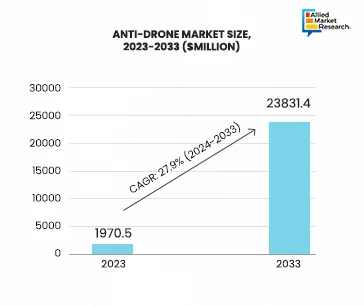
Small Satellite Market
As per Allied Market Research report on the smart satellite market, the landscape is expected to surge ahead at a CAGR of 16.4% in the 2021-2030 period and gather a revenue of $13,711.7 million by 2030. The rising investments in automation technologies and the increasing adoption of small satellites, driven by lower launch costs, are anticipated to create new growth opportunities in the market landscape. Also, the surge in demand for compact satellites due to certain advantages offered by them in space exploration properties is expected to create favorable conditions for growth in the industry.
The AMR report also throws light on the various segments of the markets on the lines of type, application, and end-user. Based on application, the satellite communication segment is estimated to have the largest revenue share in the coming period. Many commercial enterprises and businesses in the field of internet communication and networking have shifted to advanced satellite services which has contributed significantly to the expansion of the landscape in the second quarter of 2024.
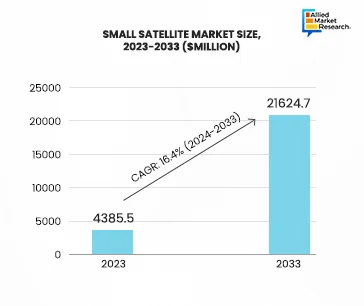
Understanding the Evolving Nature of the Aerospace and Defense Domain
The aerospace and defense sector has experienced some amazing growth in the past few years, especially in the second quarter of 2024. The AMR reports on various markets and industries in this domain emphasize the sector's evolving nature and concentrate on the key factors influencing its dynamics. The competitive scenario of the landscape is also provided in these reports with the help of scientific analytical tools such as Porter’s five forces. This exercise enables new entrants in the industry to understand the various steps they should take to improve their revenue share in the market. For instance, the military cybersecurity landscape report states that businesses should emphasize investing in emerging technologies like Artificial Intelligence, cloud computing, machine learning, etc., to gain a lead over their peers.
Final Lines
To summarize, AMR reports not only provide a comprehensive overview of the market but also analyze the minute details that influence the industry at the ground level. For this, the segmental and regional analysis presented in the study plays an important role in recording the socioeconomic, demographic, cultural, and technological factors that transform the landscape in real time. The reports thus aid businesses to focus on key investment areas, formulate their strategies accordingly, and maximize their profits in the long run.
For more insights into the aerospace and defense domain, contact our experts.

